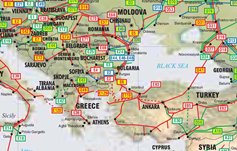
When I visited Turkey in the early 1990s, its currency was sinking so fast against the US dollar that I was able to take advantage of an exchange rate that improved with every hour that passed by changing small dollar amounts each day. Indeed, at that time the country’s economy was stuck in full “basket case” mode, hampered by statism, inflation and public debt. I am happy to say all that has changed: since the early 2000s, its economy has been growing rapidly.
Turkey’s good fortune derives in large part from its strategic position between east and west. It derives substantial revenue from the transit fees it collects from the oil and gas that traverses the country on its way from Central Asia to Europe. It’s no exaggeration to say that a maze of pipelines criss-crosses the country. They serve in part to relieve congestion in the Bosphorus, the narrow causeway separating Europe and Asia through which oil and chemical tankers pass every day, posing environmental and safety hazards.
However, it is also true that wherever pipelines go, politics follow close behind. After Turkey partnered Russia in the Blue Stream pipeline (operational since 2003), the Nabucco (Azerbaijan-Europe) and Baku-Tbilisi-Ceyhan (BTC) pipelines were conceived as a way to diminish Russia’s stranglehold on oil and gas routes in the region by routing lines direct from Central Asia to Turkey under the Black Sea. Russia has retaliated with South Stream, which will transport gas from Russia to Bulgaria under the Black Sea. There is a danger that politics will distort economics and lead to excess capacity: for this reason there it has been proposed to merge Nabucco with ITGI (the Interconnector Turkey-Greece-Italy gas pipeline). In a bizarre political twist Turkey, which imports gas from Azerbaijan, is also planning to export gas to Nakhchivan, a landlocked exclave of Azerbaijan surrounded by Armenia, which has been blockading it since the Armenia-Azerbaijan war!

Turkish oil politics have also seeped into fiction. The James Bond film The World Is Not Enough (1999) features an oil pipeline through the Caucasus from the Caspian Sea to the Mediterranean coast of Turkey. Most probably this was inspired by the BTC pipeline, which was then being planned. In the film Bond tours the proposed route of the pipeline and is attacked by armed snowmobiles. For those planning to visit the area, you have been warned!

